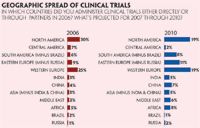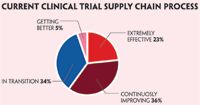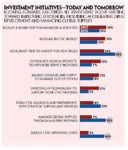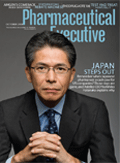Evolving Clinical Trials
Clinical trials need to change. A recent survey shows that industry should address the research supply chain for the greatest gains in effciency.
Clinical trials today cost more money, are more complex to manage, and take more time to conduct than ever before. And, going forward, executives predict a lot "more" of everything: more clinical trials, adaptive trials, regulations, geographies in which to conduct trials, and outsourcing partners.
All of these changes are needed to maintain global competitiveness. The key to their orchestration, however, lies in an efficient clinical trial supply chain (CTSC) that provides on-time delivery of supplies, with shorter lead times, and at an optimal cost. A recent survey showed that the area was ripe for investment, with executives predicting a 400 percent increase in spending from 2006 to 2010, to $60 million per company.

Geographic spread of clinical trials
To understand how these changes will unfold, BearingPoint and AMR Research conducted 107 Web-based, quantitative interviews from October to November 2007, as well as follow-up, one-on-one interviews with 11 executives in global life sciences companies. Fifty-five percent of those surveyed came from pharma, and 45 percent from biotech; multiple geographies were represented, including the US, UK, France, Germany, and Switzerland. Almost all (94 percent) of the respondents have a formal CTSC process.

Current Clinical trial supply chain process
The research revealed that most companies are focused on recruiting and retaining top managers and scientists, as well as speeding time to market for new drugs. But when asked to look forward to 2010, the executives said the focus would shift toward improving efficiencies. This included expanding current efforts to accelerate drug development, as well as initiatives to manage global supplies through multiple partners and reducing costs. (See "Investment Initiatives—Today and Tomorrow".)

Investment Initiatives-Today and Tomorrow
Bigger, more globalized trials Survey respondents reported a sharp increase in clinical studies they plan to conduct. In fact, nearly 20 percent projected a 400 percent increase in the number of trials performed, while 30 percent expect that the length of studies will increase in the 2007 to 2010 time frame.
Companies also expect to administer more clinical trials outside their home geographies, particularly in Eastern Europe, Africa, and India. (See "Geographic Spread of Clinical Trials".) With growing globalization, top challenges include managing legal and regulatory requirements, followed by establishing global operating procedures. European firms perceived regulatory requirements as more challenging, while US firms cited globalizing operating procedures as the more difficult task.

Major challenges/barriers in conducting adaptive trials
Adaptive trials Adaptive trials are on the increase, especially among US companies. (See "Major Challenges/Barriers".) These studies can speed development, but can stress the CTSC because, with more decision points throughout the trial, demand for supplies can change rapidly.

Supply Chain Challenges
To enable these studies to happen, firms have to fundamentally change their processes. Nearly 40 percent of survey respondents said their top challenge for sequential trials was developing a technology foundation to collect, manage, and analyze data, followed by making mid-course corrections (38 percent), transitioning to electronic data collection and clinical data repositories (38 percent), and lacking clear regulatory guidelines (37 percent).
Forecast accuracy It's no surprise that companies that sense demand have a higher perfect order rate, and are more likely to get the right supplies at the right time, at an optimal cost. Of the respondents that had a 60 percent or higher perfect order rate, one quarter sense changes in clinical trial demand on a daily basis.
But most companies are lax when it comes to predicting demand. Only 13 percent report that they modify their clinical trial demand forecast weekly or more frequently. Twenty-nine percent say they change their forecast quarterly, and 21 percent change it twice monthly.
Increasing the frequency of monitoring and communicating changes in demand holds a major opportunity for significant cost savings and efficiency. Going forward, traditional strategies of mitigating risks in CTSC by using inventory overages and excessive manufacturing capacity is not going to be viable. These strategies are choking R&D organizations because they lead to high costs and variability in supply chain lead times. Instead, companies should employ advanced forecasting tools to accurately predict demand.
Process improvements Ill-defined processes within R&D and lack of clear understanding of responsibilities (not to mention, the use of primitive tools—like Excel spreadsheets—for planning and inventory tracking) often cause delays in the supply chain. In fact, only 23 percent of those surveyed say their CTSC process is extremely effective, highlighting the vast opportunity for process improvement. (See below.)
Leading companies have initiated several projects that apply best practices learned from other industries in terms of process, technology, and hierarchy of metrics. This includes documentation of process flows outlining standard business rules and scenarios, management of exception situations with detailed SOPs, work instructions, and key metrics that monitor the CTSC performance as part of a continuous improvement program.
Sales and operations planning S&OP is a key supply chain concept aimed at improving collaboration among the teams managing demand and supply. Nearly two-thirds of executives said they have a process such as sales and operations planning in the CTSC to match supply and demand on a global basis. However, what they have in place is actually very different from what they need—including a formal process and mechanism for collaboration among clinical research, clinical operations, finance, logistics, compliance, and other departments. That will help companies improve the visibility of demand, review the supply chain situation in real-time, and understand the financial implications of decisions taken in managing trials.
This is seen as a major first step in moving toward a demand-driven supply network—where organizations respond to customer demand, making the supply chain more agile while lowering costs by eliminating unused inventory. A third of companies in the study have taken steps down this path, with US pharmas and European biotech firms leading the charge. Pharma should also look at best practices from other industries with demand-drive supply networks, such as high-tech, where companies fill actual, rather than an estimated demand.
Demand planning processes In demand planning, companies closely monitor the demand and supply situation for corrective actions. Today, most of this work is done in silos. Planning for each component of the clinical trial kit is done in isolation. Instead, companies should consider the bill of material approach to tie in these demands from individual sites in to achieve operational efficiencies—and save costs.
Companies should consider integrated demand planning, which is the collaborative process of monitoring and taking corrective action in real time, involving key supply chain functions like clinical supplies planning, sourcing, manufacturing, packaging, labeling and distribution in close coordination with clinical trials.
By documenting and tracking a detailed demand and supply plan in real time with accounting inventory, efficiencies can be realized in available manufacturing capacities and supply chain lead times. This can be a powerful tool to proactively manage risks by issuing alerts and advanced warnings to deal with shortfalls in clinical supplies.
CTSC outsourcing All companies already outsource some aspect of their CTSC. Currently, 30 percent of companies outsource master data management, and about a quarter outsource kit destruction, shipment logistics, cold chain logistics, and clinical services. The picture changes slightly in 2010, when 30 percent of executives say they plan to outsource business planning, followed by master data management, and clinical services (21 percent each).
While companies outsource for a number of reasons—to improve the agility of the supply chain, fill in for lack of in-house expertise, or to gain market access to countries with a lower cost base—they must still ensure that processes, roles, and responsibilities are well-defined, and that they can exchange real-time data without compromising intellectual property. This is where pharma can learn from other industries, which have engaged in outsourcing without the infrastructure needed to allow efficient collaboration, leading to rising costs and risks—rather than providing relief.
Success in the clinical trial supply chain ultimately depends on understanding people and process challenges. By benchmarking today's CTSC practices, crafting an effective strategy for internal processes, and combining it with leading technologies, life sciences companies can be prepared to deliver breakthrough products more efficiently and to sustain competitiveness in the global economy.
This is a place where pharma can learn from other industries, which have engaged in outsourcing without the infrastructure needed to allow efficient collaboration, leading to rising costs and risks—rather than providing relief.
Success in the clinical trial supply chain ultimately depends on understanding the people and process challenges. By benchmarking today's CTSC practices, crafting an effective strategy for sharpening internal processes, and combining it with leading technologies, life sciences companies can be prepared to deliver breakthrough products more efficiently and to sustain competitiveness in the global economy.
RS Kumar is senior manager with BearingPoint Life Sciences. He can be reached at rs.kumar@bearingpoint.com
Addressing Disparities in Psoriasis Trials: Takeda's Strategies for Inclusivity in Clinical Research
April 14th 2025LaShell Robinson, Head of Global Feasibility and Trial Equity at Takeda, speaks about the company's strategies to engage patients in underrepresented populations in its phase III psoriasis trials.
Bristol Myers Squibb’s Cobenfy Falls Short in Phase III Trial as Add On Therapy for Schizophrenia
April 23rd 2025In the Phase III ARISE trial, Cobenfy administered as an adjunctive treatment to atypical antipsychotics for patients with inadequately controlled schizophrenia did not achieve statistically significant improvements.
Key Findings of the NIAGARA and HIMALAYA Trials
November 8th 2024In this episode of the Pharmaceutical Executive podcast, Shubh Goel, head of immuno-oncology, gastrointestinal tumors, US oncology business unit, AstraZeneca, discusses the findings of the NIAGARA trial in bladder cancer and the significance of the five-year overall survival data from the HIMALAYA trial, particularly the long-term efficacy of the STRIDE regimen for unresectable liver cancer.
Expanding Immune Response Testing to Support Vaccine Development
April 22nd 2025Nigel McCracken, chief operating officer, Virax Biolabs, discusses the expansion of its ViraxImmune platform into areas such as transplant monitoring, vaccine efficacy, latent virus reactivation, and CAR T cell therapy.
